Recently I explored how shot types change during the final two minutes of a game. However, that only gave snapshots based on certain timeframes that I chose. Looking at how those shot types change, second by second, is much more enlightening. That is what I will be doing today. For each shot type, I will calculate the total amount of attempts from every game this year for each second.
Let’s start with three-pointers. From the last study, we saw that three-point attempts increase dramatically relative to other shot attempts in the last two minutes. Is that a late-game surge only or do three-point attempts increase progressively throughout the game? Here’s the data:

Outliers (which occurred at the end of each quarter) were removed from the graph for the sake of clarity. As you can see, there’s a significant increase in attempts as the game goes on. We also see a very rapid increase at the end of the game. I won’t speculate as to why this happens, but it certainly is interesting.
In the last two minutes, three-point attempts increase mostly at the expense of midrange/post attempts. Is this only a late-game trend, or does it gradually occur during all 48 minutes? Let’s look at midrange attempts:
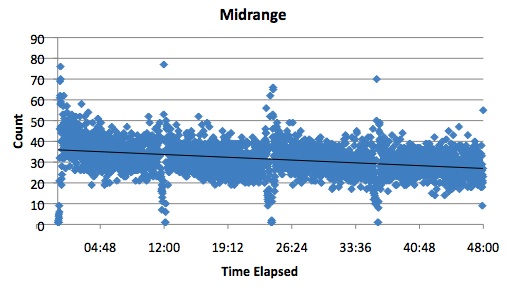
Two-point shots away from the basket appear to do the opposite of three-pointers. They start at their highest frequency and gradually decrease as the game goes on. In the final moments the decline slows, but that is because all shot attempts, regardless of shot type, increase in the final seconds.
Layups are the third shot type with a large enough sample size at each second in the game to make some sense of it:
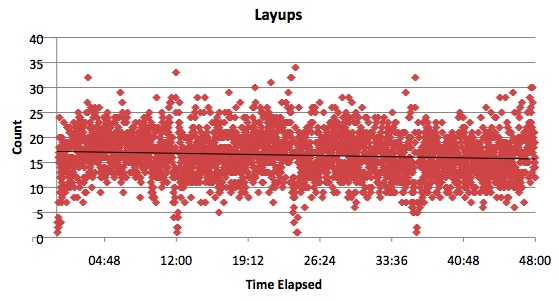
Layups decline ever so slightly as the game progresses. At the start of the game the trendline is at around 17, and by the end it is just above 15. This difference is very small and can possibly be explained by one other change as the game progresses: fouls. How do shooting fouls change over the course of a game?
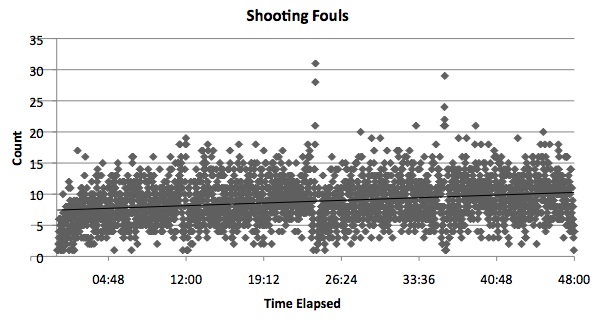
These fouls rise by about 2.5 during the 48 minutes, so it may be that layups just go down because shooting fouls (which will not show the shot type in the play-by-play) go up. We don’t know that most shooting fouls are on layup attempts, but outside shooters are rarely fouled and dunks, tips, and putbacks are infrequent enough to not be much of a factor.
What about those dunks, tips, and putbacks? I’ve put together graphs on all three shot types, but good luck making any sense of them:
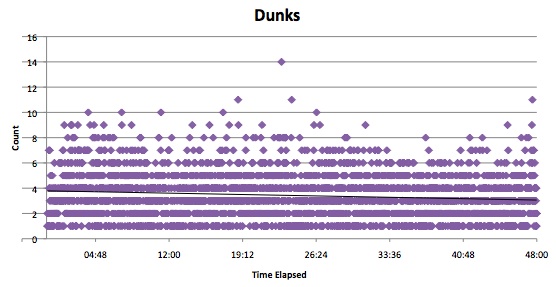
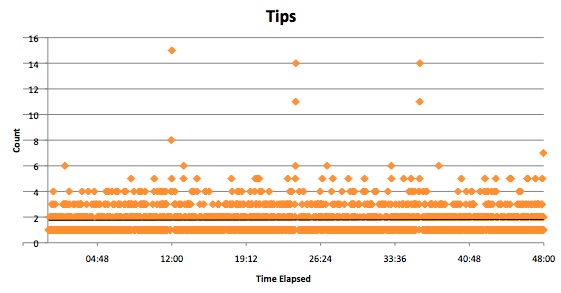

In conclusion, teams don’t move away from midrange/post and towards three-point shots only in the last two minutes. This appears to be a phenomenon that occurs from the very start of the game. Also, layups go down as the game progresses, but this may just be because of an increase in shooting fouls.
Although this information is interesting at the league-wide level, it may be even more helpful on a team-by-team basis. If you knew how a certain team changes its style as the game progresses, it would be easier to game plan for them. This is something I will look into studying in the future.